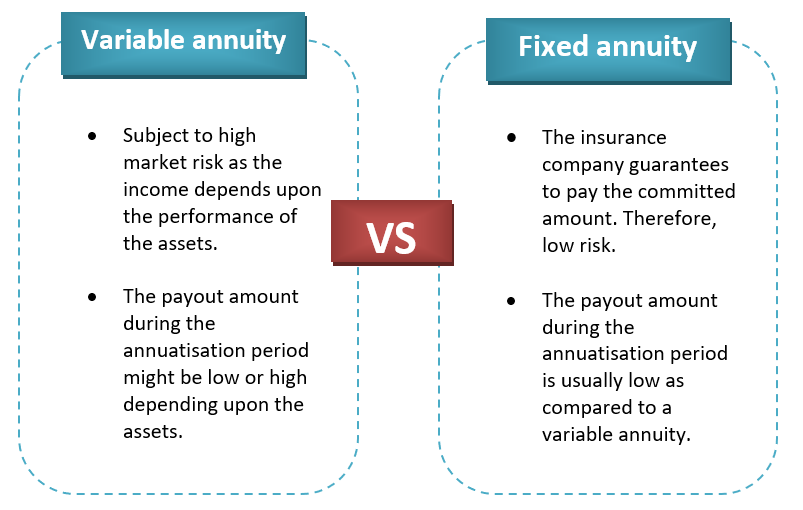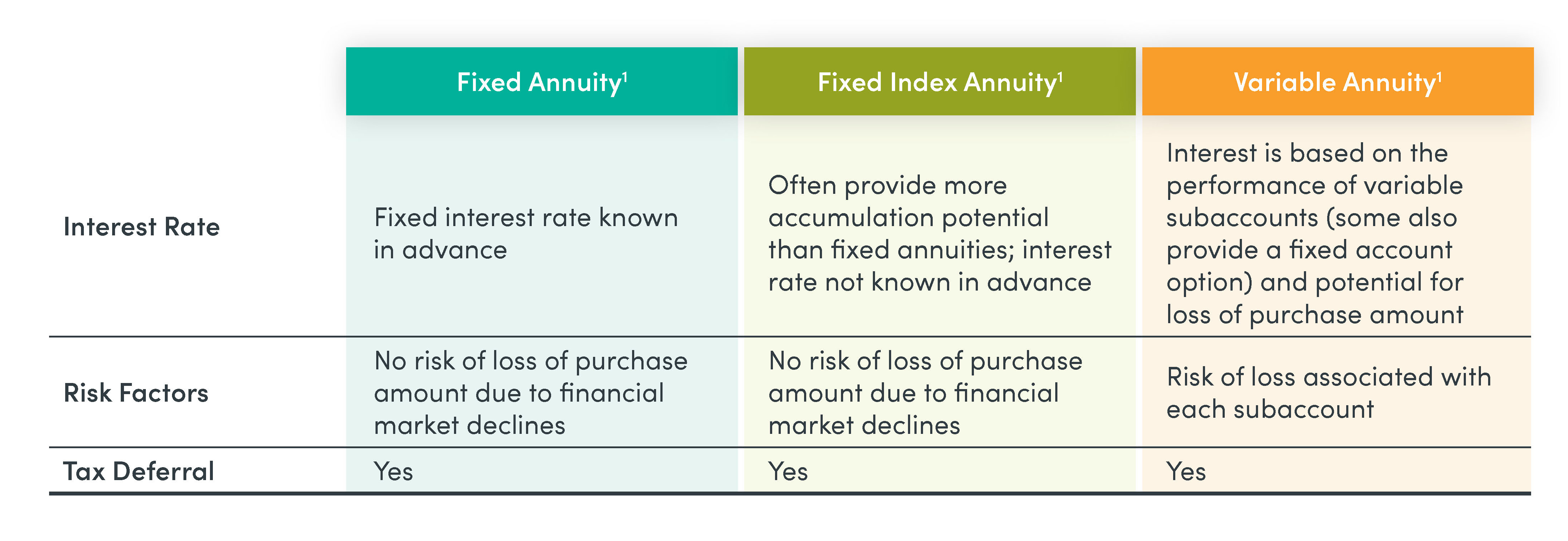All Categories
Featured
Table of Contents
The settlement could be invested for development for a lengthy duration of timea single costs deferred annuityor invested for a short time, after which payout beginsa solitary premium prompt annuity. Single costs annuities are often moneyed by rollovers or from the sale of an appreciated property. A flexible premium annuity is an annuity that is intended to be moneyed by a collection of payments.
Owners of fixed annuities understand at the time of their purchase what the worth of the future cash money flows will certainly be that are generated by the annuity. Obviously, the number of cash flows can not be known in advance (as this depends upon the agreement proprietor's life-span), however the ensured, repaired interest price at the very least offers the owner some level of certainty of future earnings from the annuity.
While this distinction appears simple and straightforward, it can substantially affect the value that a contract proprietor eventually originates from his/her annuity, and it produces substantial uncertainty for the contract owner - Fixed income annuities. It also normally has a product effect on the degree of costs that an agreement proprietor pays to the providing insurance provider
Set annuities are typically used by older capitalists who have actually limited assets yet who intend to counter the threat of outlasting their possessions. Fixed annuities can work as a reliable tool for this objective, though not without specific disadvantages. For instance, when it comes to instant annuities, as soon as a contract has actually been purchased, the contract proprietor relinquishes any kind of and all control over the annuity properties.
Understanding Financial Strategies A Comprehensive Guide to Fixed Vs Variable Annuity Pros Cons Defining Variable Vs Fixed Annuity Benefits of Choosing the Right Financial Plan Why Variable Annuity Vs Fixed Annuity Can Impact Your Future How to Compare Different Investment Plans: A Complete Overview Key Differences Between Different Financial Strategies Understanding the Risks of Long-Term Investments Who Should Consider Strategic Financial Planning? Tips for Choosing the Best Investment Strategy FAQs About Fixed Annuity Vs Variable Annuity Common Mistakes to Avoid When Planning Your Retirement Financial Planning Simplified: Understanding Your Options A Beginner’s Guide to Smart Investment Decisions A Closer Look at How to Build a Retirement Plan
An agreement with a normal 10-year abandonment duration would certainly charge a 10% abandonment fee if the contract was surrendered in the first year, a 9% surrender fee in the second year, and so on until the surrender cost reaches 0% in the agreement's 11th year. Some postponed annuity contracts contain language that enables tiny withdrawals to be made at different periods throughout the abandonment duration scot-free, though these allocations generally come with a cost in the type of lower surefire rate of interest rates.
Simply as with a taken care of annuity, the proprietor of a variable annuity pays an insurer a round figure or collection of payments for the pledge of a collection of future settlements in return. But as mentioned over, while a taken care of annuity expands at an ensured, continuous price, a variable annuity grows at a variable price that relies on the efficiency of the underlying financial investments, called sub-accounts.
During the build-up stage, properties purchased variable annuity sub-accounts grow on a tax-deferred basis and are strained only when the contract owner takes out those profits from the account. After the accumulation stage comes the earnings stage. Gradually, variable annuity possessions ought to theoretically raise in worth till the contract proprietor determines he or she wish to begin withdrawing money from the account.
The most significant concern that variable annuities commonly present is high expense. Variable annuities have a number of layers of charges and expenditures that can, in aggregate, produce a drag of up to 3-4% of the agreement's worth each year.
M&E expenditure costs are calculated as a percent of the agreement value Annuity companies hand down recordkeeping and other administrative expenses to the agreement proprietor. This can be in the kind of a level annual cost or a percent of the agreement worth. Management fees may be consisted of as component of the M&E threat cost or may be analyzed individually.
These fees can range from 0.1% for easy funds to 1.5% or more for actively handled funds. Annuity contracts can be tailored in a variety of methods to offer the certain demands of the contract proprietor. Some typical variable annuity cyclists consist of guaranteed minimal accumulation benefit (GMAB), ensured minimum withdrawal benefit (GMWB), and ensured minimum earnings benefit (GMIB).
Exploring Fixed Vs Variable Annuities Everything You Need to Know About Variable Vs Fixed Annuity Defining the Right Financial Strategy Pros and Cons of Various Financial Options Why Annuities Fixed Vs Variable Is a Smart Choice Retirement Income Fixed Vs Variable Annuity: Explained in Detail Key Differences Between Fixed Income Annuity Vs Variable Annuity Understanding the Rewards of Fixed Income Annuity Vs Variable Growth Annuity Who Should Consider Pros And Cons Of Fixed Annuity And Variable Annuity? Tips for Choosing the Best Investment Strategy FAQs About Annuities Fixed Vs Variable Common Mistakes to Avoid When Planning Your Retirement Financial Planning Simplified: Understanding Fixed Interest Annuity Vs Variable Investment Annuity A Beginner’s Guide to Smart Investment Decisions A Closer Look at Fixed Interest Annuity Vs Variable Investment Annuity
Variable annuity contributions provide no such tax obligation reduction. Variable annuities have a tendency to be very ineffective vehicles for passing wide range to the following generation since they do not appreciate a cost-basis adjustment when the original contract proprietor passes away. When the owner of a taxable financial investment account dies, the expense bases of the investments kept in the account are readjusted to mirror the market rates of those financial investments at the time of the proprietor's fatality.
Such is not the case with variable annuities. Investments held within a variable annuity do not obtain a cost-basis adjustment when the initial owner of the annuity dies.

One considerable issue associated to variable annuities is the possibility for conflicts of interest that might feed on the component of annuity salespeople. Unlike a financial consultant, that has a fiduciary obligation to make financial investment decisions that benefit the client, an insurance broker has no such fiduciary commitment. Annuity sales are extremely lucrative for the insurance coverage professionals that offer them as a result of high upfront sales payments.
Several variable annuity agreements consist of language which puts a cap on the percent of gain that can be experienced by specific sub-accounts. These caps stop the annuity owner from fully joining a portion of gains that might otherwise be enjoyed in years in which markets create considerable returns. From an outsider's point of view, presumably that investors are trading a cap on investment returns for the previously mentioned assured floor on investment returns.
Understanding Fixed Index Annuity Vs Variable Annuity A Closer Look at How Retirement Planning Works Breaking Down the Basics of Investment Plans Features of Fixed Vs Variable Annuities Why Fixed Vs Variable Annuity Pros Cons Is Worth Considering How to Compare Different Investment Plans: Explained in Detail Key Differences Between Different Financial Strategies Understanding the Key Features of Annuities Variable Vs Fixed Who Should Consider Choosing Between Fixed Annuity And Variable Annuity? Tips for Choosing the Best Investment Strategy FAQs About Planning Your Financial Future Common Mistakes to Avoid When Planning Your Retirement Financial Planning Simplified: Understanding Indexed Annuity Vs Fixed Annuity A Beginner’s Guide to What Is Variable Annuity Vs Fixed Annuity A Closer Look at Fixed Income Annuity Vs Variable Growth Annuity
As kept in mind above, surrender charges can drastically restrict an annuity owner's capability to move possessions out of an annuity in the very early years of the contract. Even more, while most variable annuities permit agreement proprietors to withdraw a specified quantity throughout the accumulation stage, withdrawals yet amount commonly lead to a company-imposed cost.
Withdrawals made from a set rates of interest investment choice might likewise experience a "market value modification" or MVA. An MVA adjusts the value of the withdrawal to mirror any kind of adjustments in rates of interest from the moment that the cash was invested in the fixed-rate choice to the time that it was taken out.

Frequently, also the salesmen that offer them do not totally understand just how they function, therefore salesmen in some cases victimize a buyer's feelings to offer variable annuities instead of the values and viability of the products themselves. We think that financiers ought to totally recognize what they have and how much they are paying to have it.
Nonetheless, the exact same can not be stated for variable annuity properties kept in fixed-rate investments. These properties legitimately come from the insurer and would for that reason go to threat if the firm were to fail. Likewise, any guarantees that the insurer has accepted give, such as an assured minimum earnings advantage, would be in concern in the occasion of a business failure.
Analyzing Fixed Vs Variable Annuities Everything You Need to Know About Pros And Cons Of Fixed Annuity And Variable Annuity Defining the Right Financial Strategy Features of Smart Investment Choices Why Choosing the Right Financial Strategy Is a Smart Choice Fixed Income Annuity Vs Variable Annuity: How It Works Key Differences Between Different Financial Strategies Understanding the Rewards of Deferred Annuity Vs Variable Annuity Who Should Consider Strategic Financial Planning? Tips for Choosing Fixed Vs Variable Annuities FAQs About Variable Annuity Vs Fixed Annuity Common Mistakes to Avoid When Choosing a Financial Strategy Financial Planning Simplified: Understanding Fixed Annuity Or Variable Annuity A Beginner’s Guide to Smart Investment Decisions A Closer Look at Fixed Annuity Or Variable Annuity
As a result, prospective purchasers of variable annuities ought to recognize and think about the economic condition of the issuing insurer before participating in an annuity agreement. While the advantages and downsides of various kinds of annuities can be questioned, the real concern bordering annuities is that of viability. Put just, the inquiry is: that should own a variable annuity? This concern can be tough to address, given the myriad variants readily available in the variable annuity world, but there are some standard guidelines that can aid capitalists determine whether annuities must contribute in their monetary plans.
After all, as the stating goes: "Caveat emptor!" This short article is prepared by Pekin Hardy Strauss, Inc. ("Pekin Hardy," dba Pekin Hardy Strauss Wealth Monitoring) for informative objectives just and is not planned as a deal or solicitation for organization. The information and data in this article does not make up lawful, tax, bookkeeping, financial investment, or other expert suggestions.
Table of Contents
Latest Posts
Exploring the Basics of Retirement Options Everything You Need to Know About Financial Strategies Defining Fixed Interest Annuity Vs Variable Investment Annuity Benefits of Fixed Indexed Annuity Vs Ma
Highlighting the Key Features of Long-Term Investments Key Insights on What Is A Variable Annuity Vs A Fixed Annuity What Is Variable Vs Fixed Annuities? Advantages and Disadvantages of Different Reti
Breaking Down Your Investment Choices A Comprehensive Guide to Investment Choices What Is the Best Retirement Option? Pros and Cons of Variable Annuities Vs Fixed Annuities Why Choosing the Right Fina
More
Latest Posts